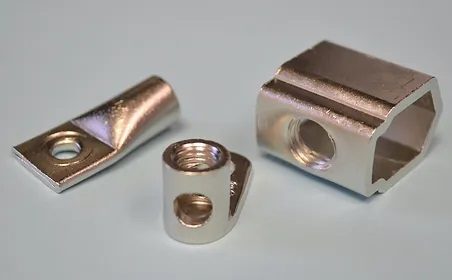Electrolytic and electroless nickel plating are essential surface treatment methods that significantly enhance the performance and longevity of metal components. While our services at Alternate Finishing, Inc. cover both techniques, each of them has distinct advantages like a controlled thicker coating for electrolytic plating and uniform coverage for electroless plating.
Both methods are used across industries to improve corrosion resistance, wear properties, electrical conductivity, and more to ensure that components can withstand harsh environments and perform reliably over time.
Here, we specifically go over the electrolytic and electroless nickel plating services as offered at Alternate Finishing, Inc. and talk about their specific use cases.
Our Nickel Plating Methods and Standards
At Alternate Finishing, Inc. we offer two approaches to our nickel plating service: Electroless and electrolytic.
The electroless process employs a chemical reduction technique wherein nickel ions in a solution are reduced and deposited onto a substrate without the need for an external power source. This procedure offers great uniformity and coverage, even on complex geometries, which is ideal for so many applications.
In electrolytic nickel plating, we use an electric current to drive the deposition of nickel ions from a solution onto a substrate. This method gives better control over the deposition rate and yields thicker coatings.
We can apply nickel plating that meets these specifications:
Request a Quote

Why Electroless Nickel Plating?
The primary objective of this process in electronics is to apply a protective coating against corrosion and wear. The nickel layer functions as a barrier that does not allow the diffusion of underlying metals like copper into other layers such as gold.
Nickel plating provides better surface electrical conduction and contact resistance, which ensures a reliable electrical performance. It also improves the mechanical characteristics of the substrate, so no physical deformation due to repeated use acts on it.
Electroless plating provides uniform coverage and is the preferred option for high-stress and harsh environments such as industrial machinery and aerospace equipment.
Unlike electroless nickel plating services, our electrolytic nickel plating service is a good choice when uniform coverage is not a vital concern, or when aesthetics are more important. Electrolytic plating is usually less expensive and sufficient for low-stress applications.
Electroless Nickel Plating Applications
At Alternate Finishing, we use electroless plating for various applications, including:
- Improving corrosion resistance and electrical conductivity in connectors and contact surfaces.
- Protecting PCB circuit board traces from oxidation and improving their solderability.
- Providing a durable and corrosion-resistant finish for electronic metal enclosures.
- Making semiconductors more reliable by protecting them against environmental degradation.
Electrolytic Nickel Plating
An important consideration for many electronics in various industries is to have strong, wear-resistant components to withstand demanding environments. While there are many ways to achieve this goal, one of those is electrolytic nickel plating.
But of course this method isn’t the only one that manufacturers consider. This is because other methods like electroless nickel plating also have some advantages over this one. Here is an overview that weighs the strengths and limitations of electrolytic nickel plating that manufacturers can consider to determine its suitability for their needs.
Pros
- Precise Thickness Control: Allows for specific thickness levels, making it ideal for applications requiring varying coating depths.
- High Hardness: Produces a durable and wear-resistant surface.
- Cost-Effective for Simple Shapes: Suitable for straightforward geometries where uniformity isn’t critical.
- Good Aesthetic Finish: Delivers a smooth and shiny appearance, beneficial for decorative purposes.
- Fast Deposition Rate: The process can be quicker than electroless plating for large-scale applications.
Cons
- Non-Uniform Coverage: May lead to uneven coatings, especially on complex or irregularly shaped parts.
- Requires External Power Source: Increases process complexity and energy costs.
- Substrate Limitations: Works best with conductive materials, limiting its versatility.
- Potential for Defects: Pinholes or irregularities can occur without precise control.
Electroless Nickel Plating
There are tremendous advantages to using this method in PCB plating – which is why it has a wide appeal in so many industries like automotive, aerospace, and electronics. For instance, many other methods can’t match its performance on complex geometries and non-conductive substrates.
But even with all its strengths, it still falls short in some areas which is why it is still necessary to consider its benefits and limitations before using it in any plating applications. Consider the advantages and disadvantages of using it to help you decide if it’s the best choice for your project.
Pros
- Uniform Coating: Electroless nickel plating provides even coverage across all surfaces, including intricate shapes and recesses.
- Superior Corrosion Resistance: Excellent for harsh environments and high-stress applications.
- Does Not Require Electricity: Simplifies the process and reduces energy costs.
- Enhanced Surface Hardness: Offers a hard, wear-resistant layer ideal for demanding conditions.
- Versatile Application: Suitable for both conductive and non-conductive substrates.
Cons
- Slower Deposition Rate: Takes longer compared to electrolytic plating, increasing processing time.
- Higher Material Costs: Requires specialized chemical solutions, making it more expensive.
- Limited Thickness: Achieving very thick layers can be challenging and time-consuming.
- Complex Bath Maintenance: Requires careful monitoring of the chemical bath to ensure consistent quality.
Work With Us
At Alternate Finishing, Inc., we serve customers across the USA and Canada with precious metal plating services including electrolytic and electroless nickel plating services. We plate all types of printed circuits and many other parts. If you want your job done reliably and with quick turnarounds, call us for a quote.
